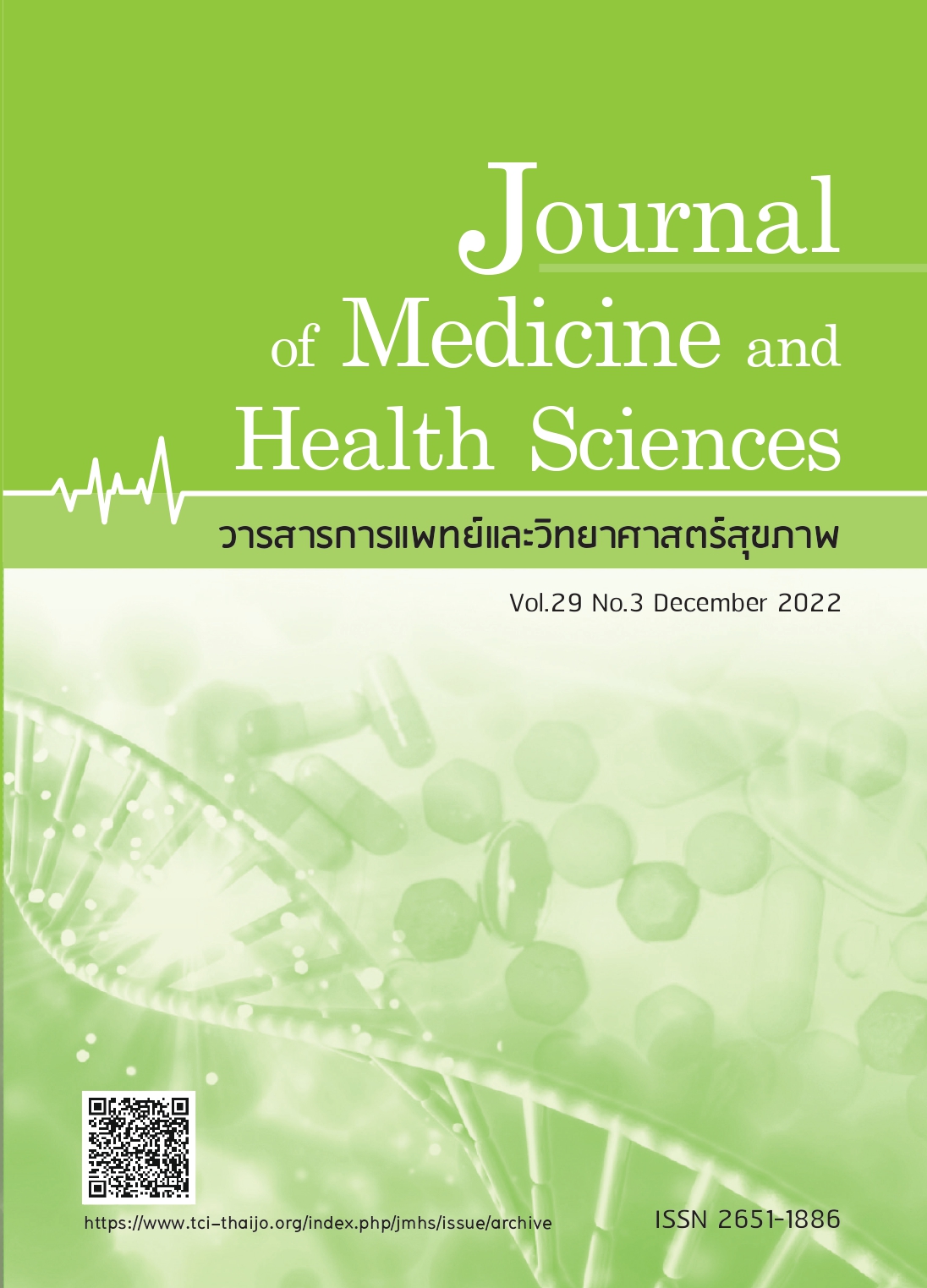Recovery of inspiratory muscle strength in lobectomy patients receiving physical therapy
Keywords:
Inspiratory muscle strength, Maximum inspiratory pressure, Lung resection, Video-assisted thoracoscopic surgery, ThoracotomyAbstract
Abstract
This study examines evidence of a lack of inspiratory muscle strength after a lobectomy. The purposes of this study are to examine the changes in inspiratory muscle strength after a lobectomy and to compare inspiratory muscle strength between video-assisted thoracoscopic surgery (VATS) and thoracotomy groups. This retrospective study included lobectomy patients who received physical therapy treatment between May 2018 and December 2020 at the Central Chest Institute of Thailand. Maximal inspiratory pressure (MIP) determined inspiratory muscle strength and was investigated at different times: preoperative, postoperative on discharge day, and two weeks after follow-up. The data were analyzed using two-way repeated ANOVA. There were 61 eligible participants who underwent lobectomy via VATS (n=45) or Thoracotomy (n=16). MIP was significantly decreased on discharge day when compared to preoperative values (p<0.001) and was returned to the preoperative level for two weeks follow-up. When comparing between VATS and Thoracotomy, there was no difference in MIP at discharge day and two weeks follow-up. In conclusion, patients undergoing a lobectomy via VATS or Thoracotomy and received physical therapy treatment suffered the same reduction in postoperative inspiratory muscle strength and recovered to preoperative levels within two weeks of follow-up.
References
Montagne F, Guisier F, Venissac N, et al. The role of surgery in lung cancer treatment: present indications and future perspectives—state of the art. Cancers (Basel) 2021;13:3711. doi: 10.3390/cancers 13153711.
Landreneau RJ, Hazelrigg SR, Mack MJ, et al. Postoperative pain-related morbidity: video-assisted thoracic surgery versus thoracotomy. Ann Thorac Surg 1993;56:1285-9.
He J, Xu X. Thoracoscopic anatomic pulmonary resection. J Thorac Dis 2012;4:520-47.
McKenna RJ, Houck WV. New approaches to the minimally invasive treatment of lung cancer. Curr Opin Pulm Med 2005;11:282-6.
Sugiura H, Morikawa T, Kaji M, et al. Longterm benefits for the quality of life after video-assisted thoracoscopic lobectomy in patients with lung cancer. Surg Laparosc Endosc Percutan Tech 1999;9:403-8.
Sasaki N, Meyer MJ, Eikermann M. Postoperative respiratory muscle dysfunction: Pathophysiology and preventive strategies. Anesthesiology 2013;118:961-78.
Miranda AP, de Souza HC, Santos BF, et al. Bilateral shoulder dysfunction related to the lung resection area after thoracotomy.Medicine (Baltimore) 2015;94:e1927.
Kendall F, Abreu P, Pinho P, et al. The role of physiotherapy in patients undergoing pulmonary surgery for lung cancer. A literature
review. Rev Port Pneumol 2017;23:343-51. doi: 10.1016/j.rppnen.2017.05.003.
Baddeley RA. Physiotherapy for enhanced recovery in thoracic surgery. J Thorac Dis 2016;8:S107-10.
Ahmad AM. Essentials of physiotherapy after thoracic surgery: What physiotherapists need to know. A narrative review. Korean J Thorac Cardiovasc Surg 2018;51:293-307.
Jonsson M, Ahlsson A, Hurtig-Wennlof A, et al. In-hospital physiotherapy and physical recovery 3 months after lung cancer surgery: A randomized controlled trial. Integr Cancer Ther 2019;18: 1534735419876346.
Bien UDS, Souza GF, Campos ES, et al. Maximum inspiratory pressure and rapid shallow breathing index as predictors of successful ventilator weaning. J Phys Ther Sci 2015;27:3723-7. doi: 10.1589/jpts. 27.3723.
American Thoracic Society/European Respiratory Society. ATS/ERS Statement on respiratory muscle testing. Am J Respir Crit Care Med 2002;166:518-624.
Evans JA, Whitelaw WA. The assessment of maximal respiratory mouth pressures in adult. Respir Care 2009;54:1348-59.
Caruso P, Albuquerque AL, Santana PV, et al. Diagnostic method assess inspiratory and expiratory muscle strength. J Bras Pneumol 2015;41:110-23.
Nomori H, Horio H, Fuyuno G, et al. Respiratory muscle strength after lung resection with special reference to age and procedures of thoracotomy. Eur J Cardiothorac Surg 1996;10:352-8.
Ichikawa T, Yokoba M, Horimizu Y, et al. Recovery of respiratory muscle, physical functions, and dyspnea after lobectomy for lung cancer. Eur Respir J 2019;54:OA3791.doi: 10.1183/13993003.congress-2019. OA3791.
Rizk NP, Ghanie A, Hsu M, et al. A prospective trial comparing pain and quality of life measures after anatomic
lung resection using thoracoscopy or thoracotomy. Ann Thorac Surg 2014;98: 1160-6. doi: 10.1016/j.athoracsur.2014. 05.028.
Downloads
Published
How to Cite
Issue
Section
License

This work is licensed under a Creative Commons Attribution-NonCommercial-NoDerivatives 4.0 International License.



